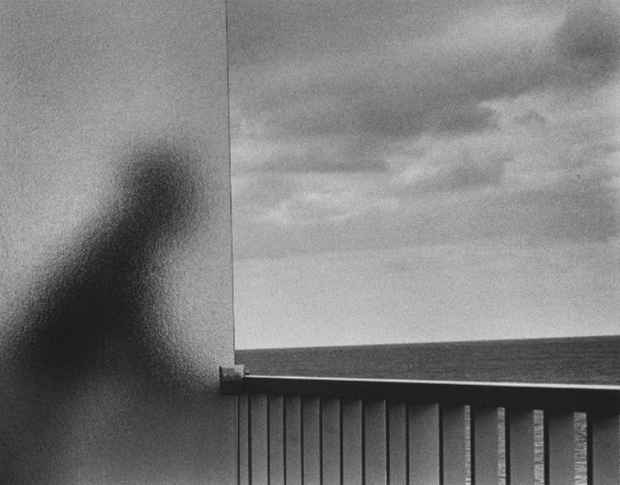“Beyond Seeing” Exhibition
Elizabeth Houston Gallery

[Image: Andre Kertesz "The Balcony, Martinique" (1972) gelatin silver print, 7 1/2 x 9 3/4 in.]
This event has ended.
“You don’t see the people you photograph, you feel them,” quipped Andre Kertesz, a lifelong motto that encapsulates the current exhibition at Elizabeth Houston Gallery more than half a century after its utterance. BEYOND SEEING has the fresh look and, more importantly, feel of a contemporary photo exhibition. On view in the gallery, Kertesz’s own The Balcony, Martinique, 1972 is as much a meditation on the line, form, and composition of geometry as it is a mysterious encounter with another, a stranger at once familiar and unfamiliar to us. That stranger may well be photography itself. We might forget that the ten masters whose smooth silver gelatin prints line the walls worked well before the contentious induction of the medium into the hallowed canon of art history, so immediate and timely is their vision.
That photography transforms and does not merely represent its subject has been an open secret since the 19th century, when Pictorialists strained to mimic romantic painting. The straight photographs of the Modernist era that superseded their efforts relished the unique capacities of the camera, but did not altogether dismiss its transformative magic. That is nowhere more clear than in the work of Aaron Siskind, Minor White, and lesser-known (but equally otherworldly) Oliver Gagliani.
Siskind is known for his Abstract Expressionism on film. Wholly unmanipulated, Chicago 22, 1960 is the sculptural detritus of an urban facade, paint applied hastily to a window obscuring illegible script, the reflection of tree branches in its glass. There is a mood that is evocative in the image, surpassing it. Minor White, whose spiritual practice transcended the Zone System, is no stranger to the symbolism of the photograph either. A student of Stieglitz’s “Equivalents,” he has infused Untitled, 1954 with an uncanny abstraction of light and shadow that elevates an ordinary object to an ethereal realm. Gagliani, too, understood the expressive potential of photographic abstraction. His Untitled, Bodega Bay, California, 1968 is musical. A wooden door and splintered window become texture and tone through the seepage of a halo of light.
Photographically, we are now talking about far more than we are saying, and envisioning far more than we are seeing. BEYOND SEEING takes us, well, beyond the forms of each composition—although those, too, are always more than meets the eye, transmogrified by the lens into the surreal—to the unconscious recognition that undergirds them. If light on film is the content of contemporary work, it was so long before Uta Barth. Already in 1943, Arthur Siegel was taking the emotional temperature of light, tone, and shadow. Exploring the singular characteristics of a medium of light writing, Siegel conjured the photograph Untitled (Black Cloth and Ring) through the slippage of camera movement.
The upshot is, of course, that photography has always been experimental, and never strictly representational. It is one thing to note that the photographers in BEYOND SEEING were ahead of their time. It is another to realize that the medium, as Charlotte Cotton would concur, is and always has been magic. Ralph Gibson and Louis Faurer prove through their street photography that even ordinary appearances are extraordinary moments of mathematics, of the convergence of lines and angles. But Gibson’s Untitled (building exterior with arrow pointing down), 1968—with its nod to Robert Frank—and Faurer’s Win, Place & Show, 1947—Frank’s often uncredited inspiration—are a far cry from simple Formalism. They are psychologically complex instances of the pace of urban life.
Photography has been abstract and expressive all along. It has also been interdisciplinary far in advance of other disciplines. Portending the computer manipulation and appropriation of contemporary art, Edmund Teske, Arthur Taussig, and Roger Catherineau experimented with photography in an expanded field. Teske’s 1954 Kenneth Anger, Topanga Canyon is an assemblage of the famous avant-garde filmmaker and Gustave Dore’s engraving of the Paradise Lost apocalypse, a fun scene to remix by sandwiching negatives. Taussig, too, makes use of existing, albeit more sunshiny, Californian, imagery in his Untitled (Signage), c. 1965, blurring the line between art and mass media. Meanwhile, Catherineau takes a different tack in L’Inconnue Revelee, 1959-60, intentionally overexposing parts of his film beyond recognition and accentuating the remnants of a woman’s face through the application of paint. All I can say is, move over Curtis Mann, there’s a new guy in town and, as it turns out, he incorporated that town.
But you shouldn’t take my word for it. If you want to see beyond seeing, the photography at Elizabeth Houston Gallery will be your induction into a longstanding artistic, and, dare I say, spiritually resonant practice.
- Robyn Day is a Chicago-based photographer and Communications Manager at the Carl & Marilynn Thoma Art Foundation. Day’s art criticism has been published in The ARTery at WBUR, Boston’s NPR news station; Art New England; Big Red & Shiny; Ain’t Bad Magazine; and Sixty Inches from Center.
Media
Schedule
from September 06, 2017 to October 14, 2017
Opening Reception on 2017-09-13 from 18:00 to 20:00